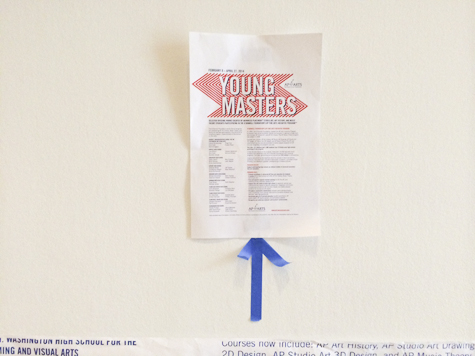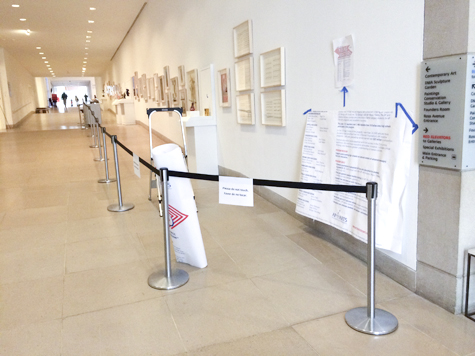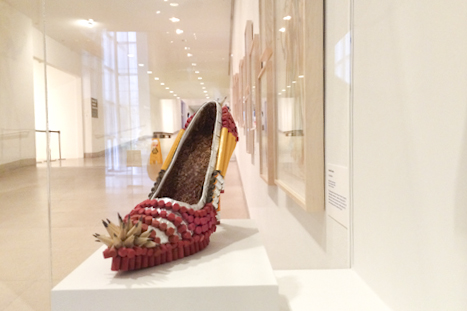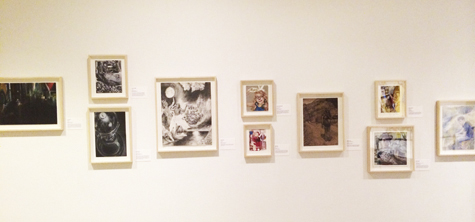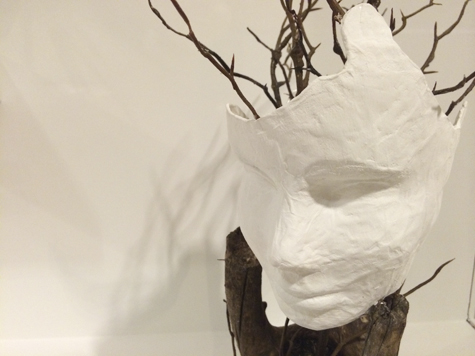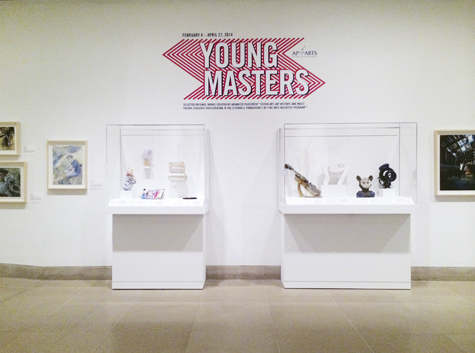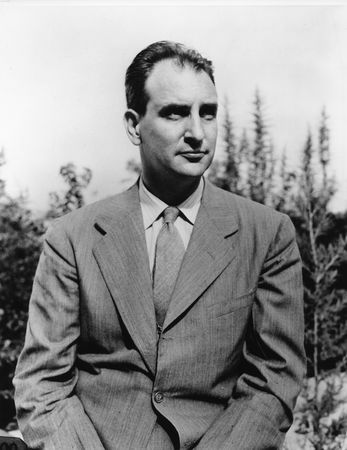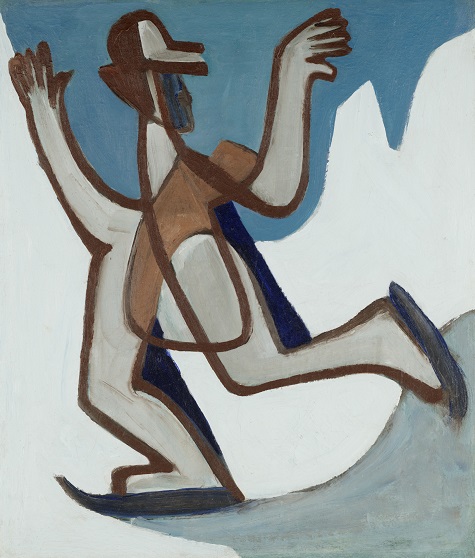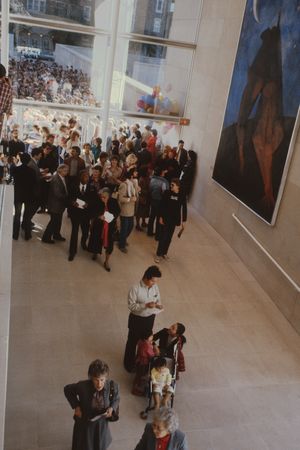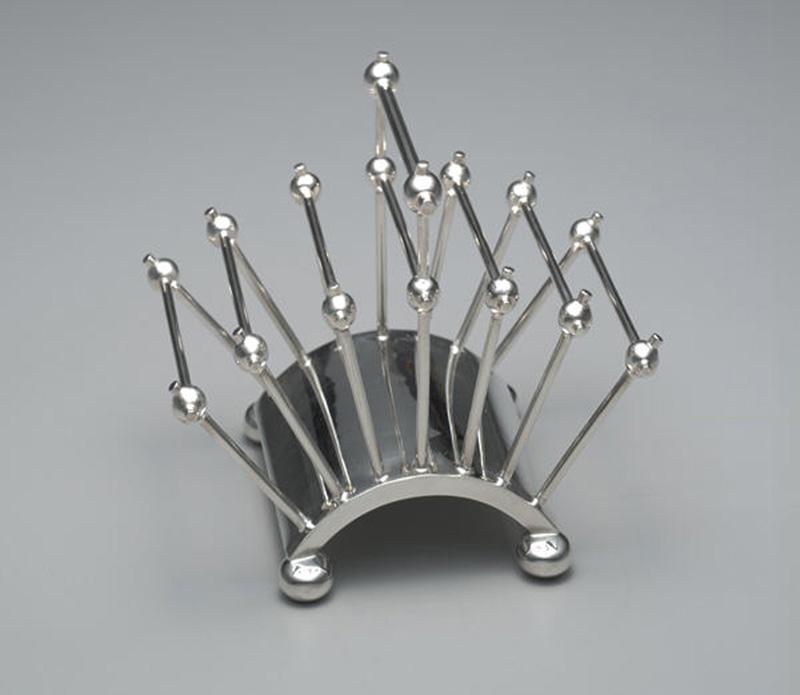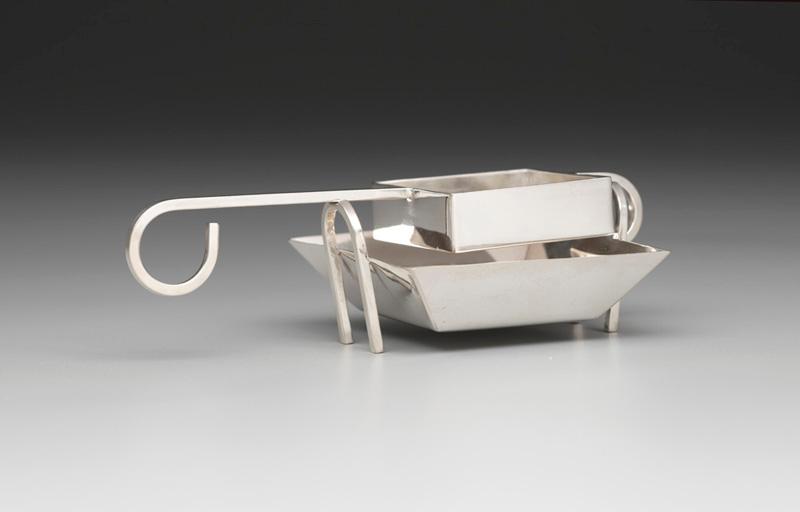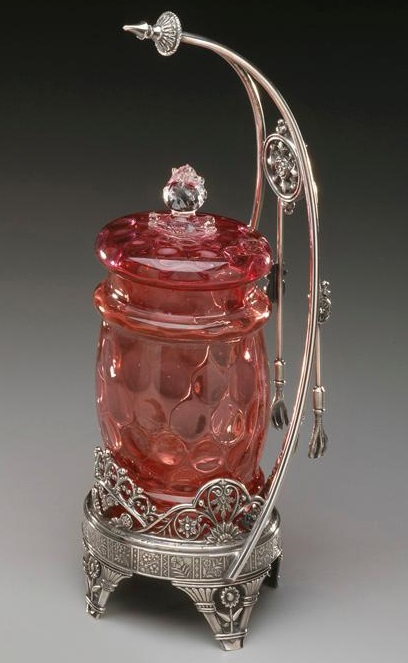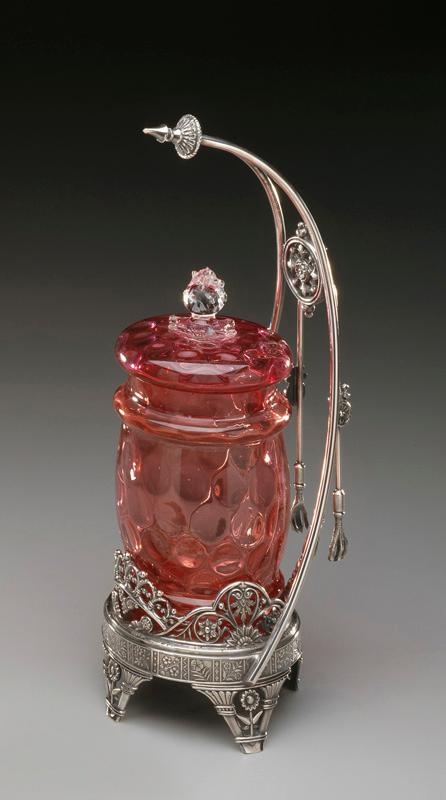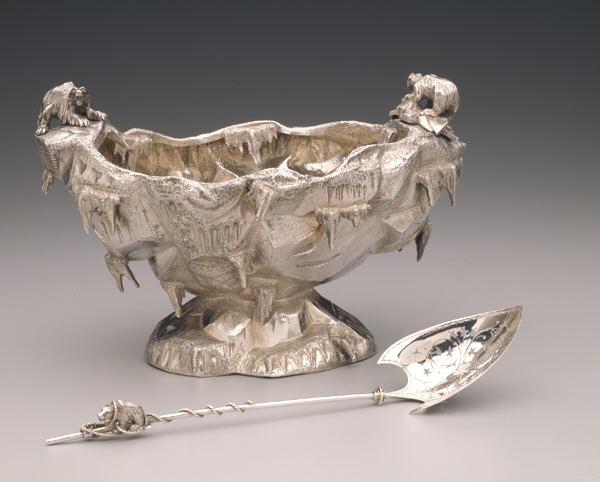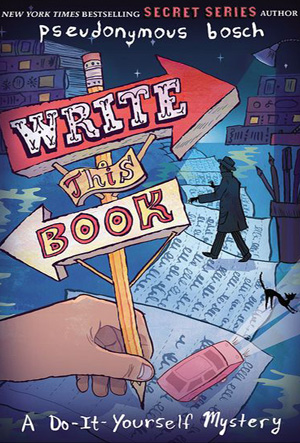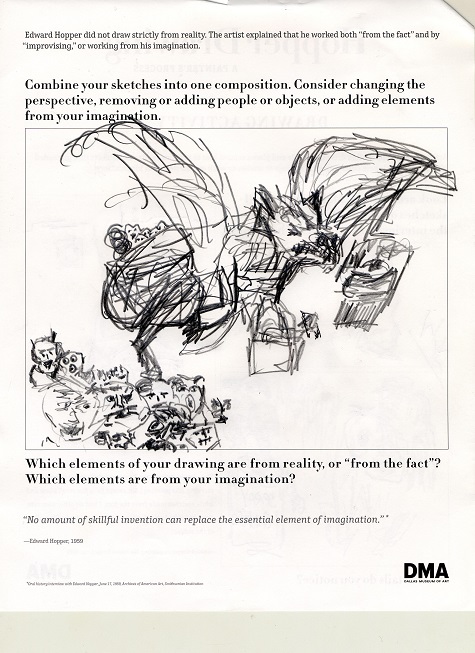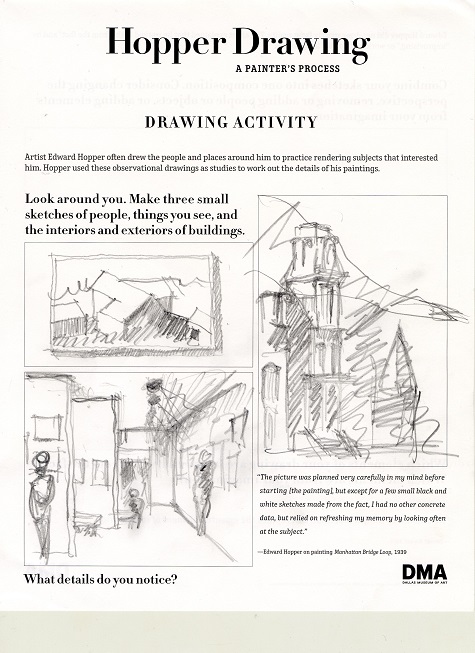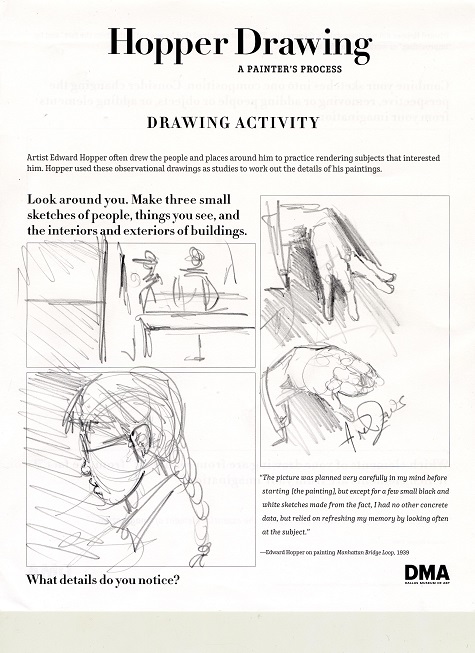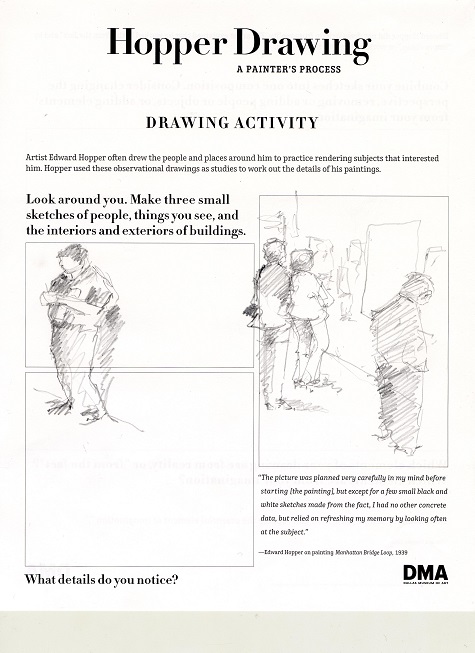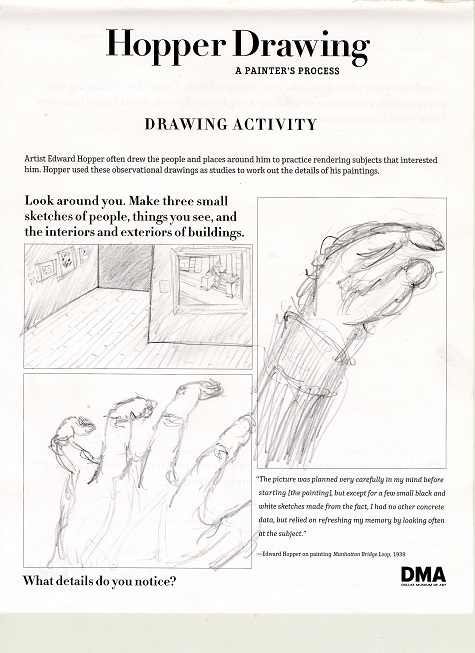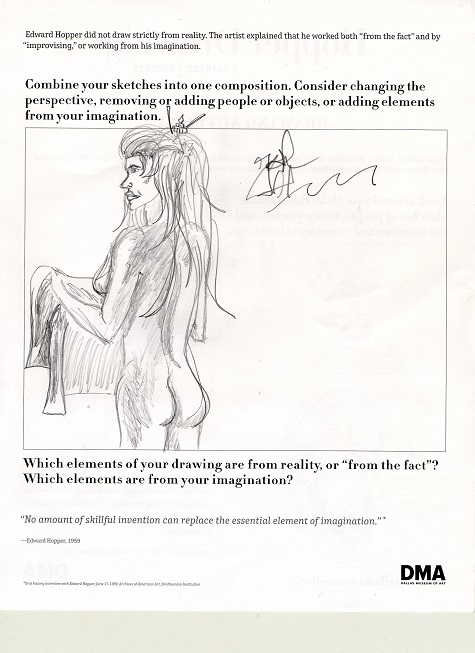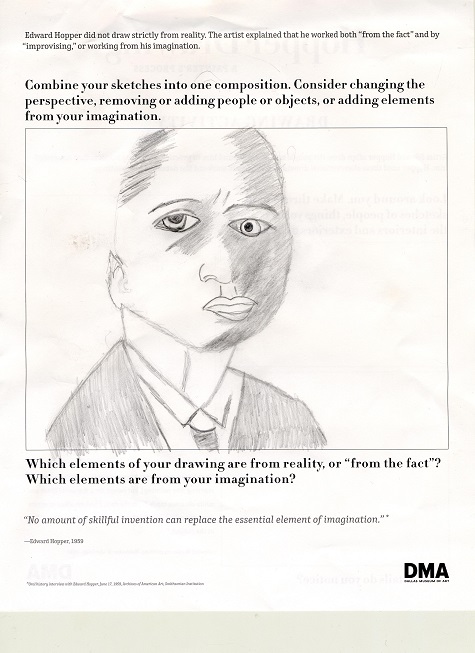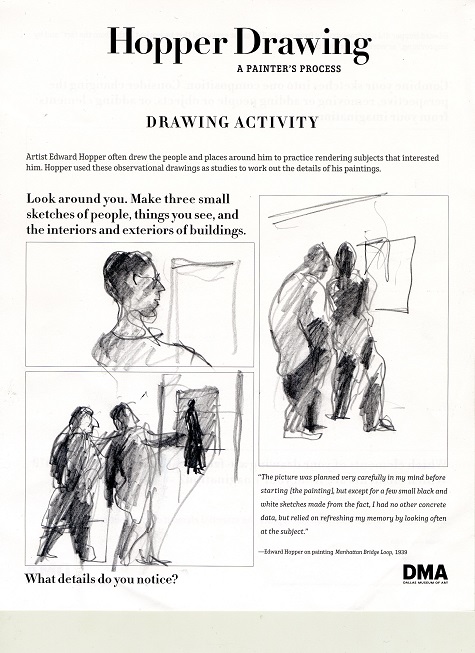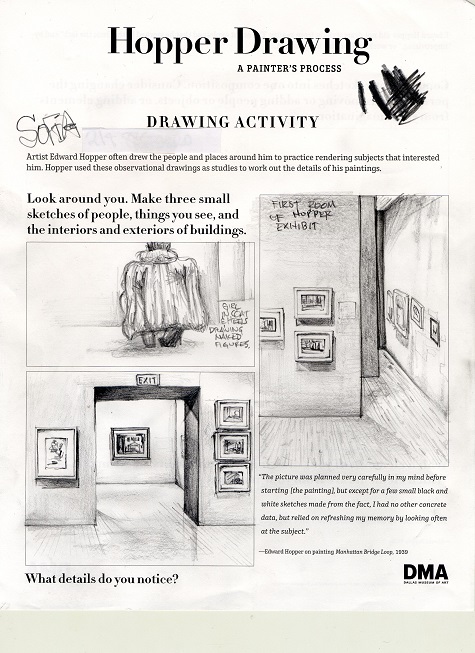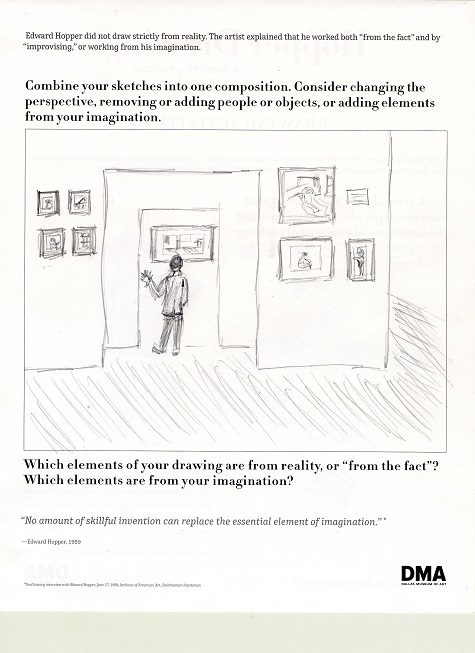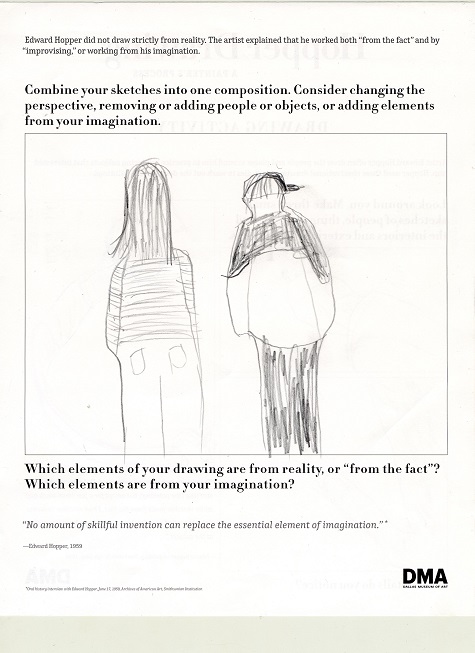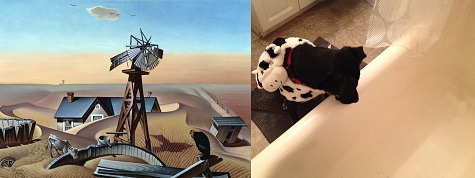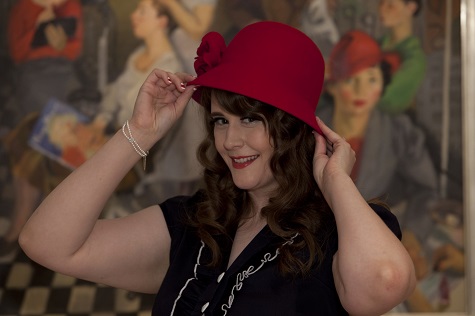The DMA’s Concourse is filled once again with art created by area AP high school students, and that means it is time for the annual Young Masters exhibition. Since 1994 North Texas art and music students have submitted their work to the O’Donnell Foundation’s AP Arts Incentive Program for a chance to be selected for the exhibition and earn scholarships. Check out this year’s selections, on view through April 27 at the DMA.
Posts Tagged 'Dallas Museum of Art'
Teenage Dream: Young Masters
Published February 10, 2014 Behind-the-Scenes , Education , Exhibitions , Teens ClosedTags: Advanced Placement® Art History, Advanced Placement® Music Theory, Advanced Placement® Studio Art, Dallas Museum of Art, DMA, Young Masters
ARTifacts: Our Own Monuments Man
Published February 5, 2014 Archive 2 CommentsTags: Dallas Museum of Art, DMA, Monuments Fine Arts and Archives, Richard Foster Howard, The Monuments Men, World War II
Did you know that a former DMA director was a Monuments Man?
Richard Foster Howard was director of the Dallas Museum of Fine Arts from December 1935 to May 1942. Howard arrived in Dallas to oversee the completion of the new museum in Fair Park and the grand Texas Centennial exhibition in 1936. He would go on to assemble the exhibition for the Pan-American Exposition in 1937 and start the Texas General, an annual juried exhibition of Texas artists.

Richard Foster Howard (standing) with jurors Xavier Gonzales, Donald Bear, and Frederick Browne judging the Texas section of the Greater Texas and Pan-American Exposition, 1937
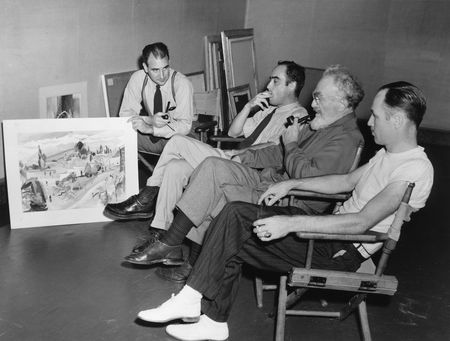
Jurors for the 1941 Texas General exhibition: (L to R) Richard Foster Howard, John McCrady, Boardman Robinson, and W. Whitzle
Education was a major focus of his tenure as director. Howard started free Saturday classes for children in 1937, began the school tour program with the Dallas Independent School District in 1937-38, established the education department with the hiring of Mrs. Alexandre (Maggie Jo) Hogue as the first full-time supervisor of education in 1939, and founded the Museum’s library in 1940.
During World War II, Howard retired from the Museum to join the army and was made a captain in the Army Field Artillery. He served in the European theater with distinction and returned to Germany in July 1946 as deputy chief of monuments, fine arts, and archives for the Office of Military Government for Germany (U.S.) He served as a Monuments Man until December 1948. For his service in returning works of art removed by Germans during the war, he was awarded the Order of the White Lion of Bohemia by the Czechoslovakian government and the Star of Italian Solidarity by the Italian government.
When Howard returned from Germany, he resumed his museum career, retiring as director of the Birmingham Museum of Art in 1975.
This Friday, learn even more about this special group of men and women with the opening of The Monuments Men movie.
Hillary Bober is the digital archivist at the Dallas Museum of Art.
Olympics in the Galleries
Published February 3, 2014 Behind-the-Scenes , Collections , Conservation ClosedTags: Dallas Museum of Art, DMA, Ernst Ludwig Kirchner, Ice Skating, Winter Olympics
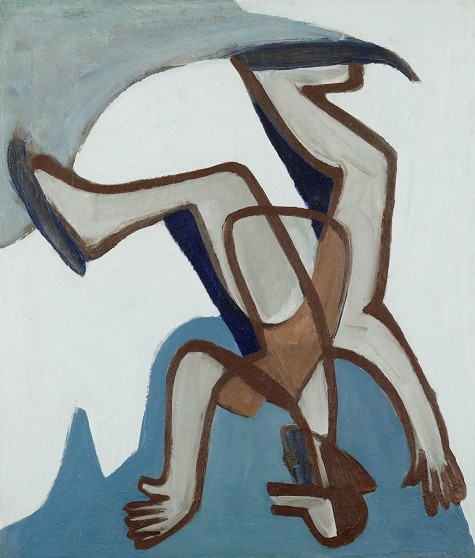
Ernst Ludwig Kirchner, Ice Skater (verso), 1929–30, oil on canvas, Dallas Museum of Art, The Eugene and Margaret McDermott Art Fund, Inc.
No, Ernst Ludwig Kirchner’s ice skater is not executing a complicated triple lutz, soon to be witnessed by billions around the world during the upcoming Winter Olympics in Sochi, Russia. He is permanently suspended in his upside-down state, having been painted on the verso of a canvas 17 years after the main painting on the other side, Four Wooden Sculptures, which depicts small primitive sculptures. Both sides of this expressionist artist’s painting can currently be seen (the skater requiring a bit of head tilting) in the DMA’s Behind the Scenes exhibition in the Conservation Gallery.
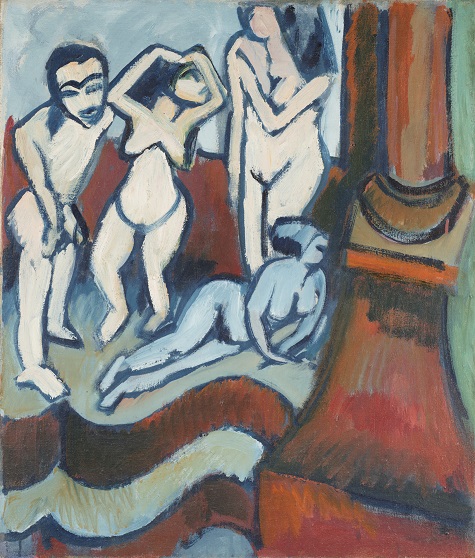
Ernst Ludwig Kirchner, Four Wooden Sculptures (recto), 1912, oil on canvas, Dallas Museum of Art, The Eugene and Margaret McDermott Art Fund, Inc.
Kirchner’s interest in the movement and agility of the human body began early in his career with depictions of Berlin and Dresden cabarets and circuses. He later found inspiration in the bicyclists who practiced racing at Berlin’s Olympia stadium. The DMA’s skater was painted after the artist moved to the Swiss Alpine mountain town of Frauenkirch, near Davos, where he would spend the last 20 years of his life. The area remains a mecca for cold-weather athletics–Davos is now home to both the Kirchner Museum and the Winter Sports Museum.
In 1930, in his essay “On Life and Work,” Kirchner reflected: “Observation of movement has been for me a particularly fruitful source of creative inspiration. From that observation comes the increased awareness of life which is the source of all artistic works.” For Kirchner, most of his sports experience was only that–observation and then the subsequent depictions thereof. The skater and other works such as Ski-Jumpers (1927) and Ice-Hockey Players (1934) were executed after his physical and mental breakdown. Archery seems to be the one sport that the artist attempted himself. In 1933, he wrote to a friend, “My wife is quite a good shot, too. It is an educational sport which makes people take up beautiful attitudes.”
And here’s a view of Kirchner’s Ice Skater that doesn’t require turning the computer upside down.
Read more about the appearance of athletic activity in Ernst Ludwig Kirchner’s work here.
Reagan Duplisea is the associate registrar, exhibitions at the DMA
Makers Made
Published January 31, 2014 Center for Creative Connections , Education , Teens ClosedTags: Center for Creative Connections, Dallas Museum of Art, DMA, Maker Club, Maker movement, STEAM education, teen art, teens
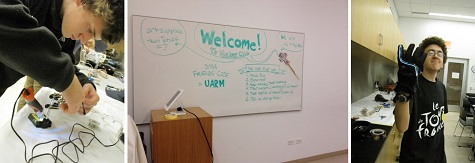
Now in its fifth month, Maker Club is a free drop-in program for ages 13-19 that asks, “What happens when art, science, and technology mix?” Capitalizing on the popularity of the Maker movement and incorporating elements from STEAM education, Maker Club is a combination between open studio and led workshop that explores a different theme each month.
Experimentation and open-endedness rule the day as traditional art materials and tech-based supplies are thrown into the ring together. Past projects have included creating a Makey Makey mini-arcade, making found-object sculptures from discarded electronics, and using electro-luminescent (EL) wire and glow-in-the-dark screen-printing ink to make light-up clothing and accessories.
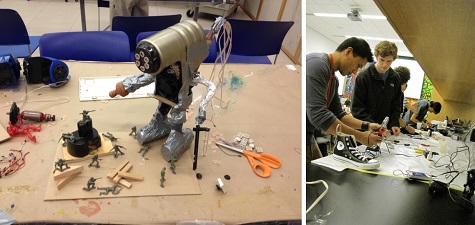
Since no experience is required to take part, Maker Club also provides an opportunity for teens to learn and “level up” a variety of skills–from new artistic processes and creative problem solving, to circuit building, soldering and more. Group learning and collaboration is also a happy by-product of this process; oftentimes, the adult facilitators are learning just as much from the students as vice versa.

So why have a maker-type program in an art museum? To me, the ideas aren’t mutually exclusive, but rather complementary. In the latest issue of Make magazine, Don Undeen, manager of the Metropolitan Museum of Art’s MediaLab, writes that all artists are, in fact, makers, and that museums have the potential to be a living forum where the two groups can talk to and inform one another.
There are even makers in the DMA’s collection, and those artists inspire the Makers Club members. Martin Delabano’s Family Portrait gave one teen the idea for this found-object sculture (pictured below). See how many makers you can spot in the DMA’s collection on your next visit.
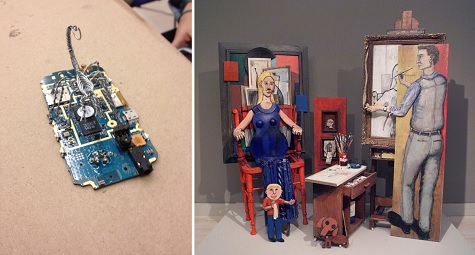
Martin Delabano, Family Portrait 1963, 2001, mixed media, Dallas Museum of Art, gift of Mr. and Mrs. Bryant M. Hanley, Jr., Lorine and David H. Gibson, and Sonny Burt and Bob Butler
JC Bigornia is the C3 program coordinator at the DMA.
Happy 30th Anniversary 1717 N. Harwood
Published January 29, 2014 Archive ClosedTags: 1984, 30th anniversary, Dallas Museum of Art, DMA, Harwood Street
January 29, 1984, was a warm, clear day. At 12:15 p.m. a ribbon was cut . . .
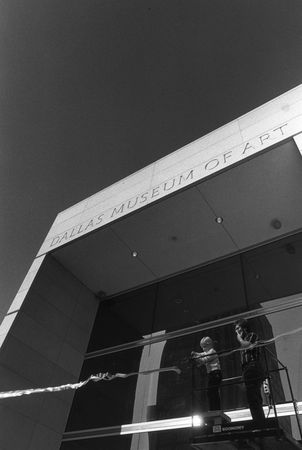
Ribbon cutting ceremony on January 29, 1984, marking the grand public opening of the Dallas Museum of Art’s new downtown location.
Visitors poured into the new galleries . . .
And the great city of Dallas finally got the great art museum it deserved.
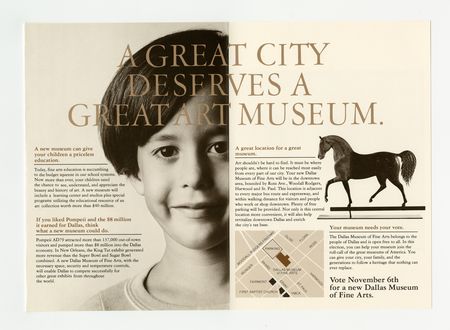
Brochure with the slogan “A great city deserves a great art museum,” encouraging Dallas residents to vote “yes” in the 1979 bond election to provide funds to build the new Dallas Museum of Art
Hillary Bober is the digital archivist at the Dallas Museum of Art.
Get Immersed in Contemporary Art
Published January 28, 2014 Art & Teaching ClosedTags: Art, Contemporary Art, Dallas Museum of Art, Pop-Up Art Spot, senses, Tyler Rutledge, works of art
Have you ever wondered how it would feel to create a painting over eight feet tall and almost seven feet wide? If so, stop by our newest Pop-up Art Spot in the Contemporary gallery and get immersed in Richard Diebenkorn‘s Ocean Park No. 29. Visitors of all ages are invited to assemble a life-size puzzle of this painting with large pieces of felt. Just be ready to get physical as you bend over, stretch, and reach as far as you can to put it together!
- Toast rack
- Tea strainer with caddy
- Pickle jar on stand with tongs
- Ice bowl and spoon
This Pop-up Art Spot engages other senses, too: use your sense of touch (unusual in an art museum!) as you explore the texture of oil paint on small canvas samples or pair different scents with the colorful paintings around you.
Below is our upcoming schedule for the Pop-up Art Spot. We change locations from week to week, so be sure to visit us between February 11-16 to engage your senses!
- January 28-February 2: fourth floor landing, Modern American gallery
February 4-9: third floor, Indonesian gallery
February 11-16: first floor, Contemporary gallery
P.S. – This Pop-up Art Spot was created by our wonderful intern Tyler Rutledge, who was featured in a blog post last month.
Melissa Gonzales
C3 Gallery Manager
Your Inner Edward Hopper
Published January 27, 2014 Education , Exhibitions ClosedTags: Dallas Museum of Art, DMA, drawing, Edward Hopper, Hopper Drawing: A Painter's Process, sketching
Hopper Drawing: A Painter’s Process show us in exciting detail the creative process of painter Edward Hopper. We see him working out the shapes and angles of spaces and subjects that interested him—subjects and spaces that would become the focal points of his famous paintings. When you visit the exhibition, look for little differences in his drawings and paintings, as Hopper often tweaked the composition’s point-of-view, added or eliminated figures, and used creative license to make visual departures from reality.
As you meander through his preparatory sketches and drawings, consider testing out your own creative process. Pick up a pencil and a clipboard at the exhibition’s entrance and sketch what you see: it could be an interesting corner, a Museum visitor in a fabulous hat, or a tree in Klyde Warren Park. Then, on the back of the page, channel your inner Edward Hopper and combine your observations into a composition that incorporates some of your imagination. As Edward Hopper once said, “no amount of skillful invention can replace the essential element of imagination.”
Check out the artistic process of other DMA visitors!
Andrea Severin Goins is the interpretation specialist at the DMA
Silver, Pearls, and Squirrels: The DMA’s Newest Acquisition
Published January 15, 2014 Collections 1 CommentTags: Dallas Museum of Art, DMA, Vienna Workshops, Wiener Werkstätte, Wittgenstein Silver Cabinet
The Dallas Museum of Art recently acquired the Wittgenstein silver cabinet, a stunning example of early 20th-century design from the Wiener Werkstätte (Vienna Workshops, founded 1903), which was a major producer of lavishly designed silverwork. Intended to be a work of art as much as the objects housed within it, the cabinet (also called a “vitrine”) demonstrates a shift in design toward an elaborate ornamental aesthetic.
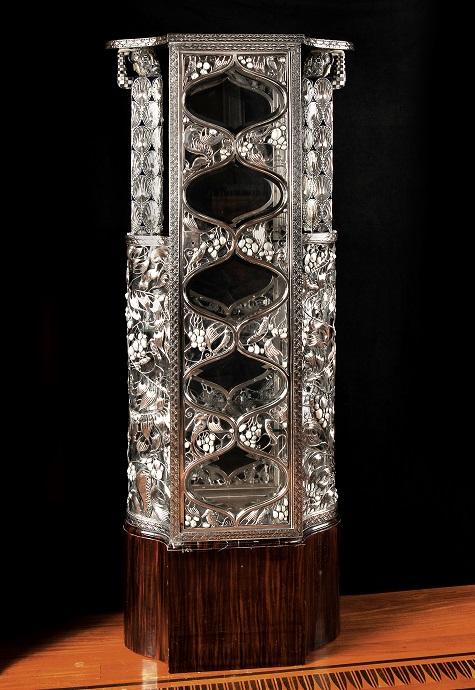
Silver vitrine (for the 1908 Kunstschau), 1908, Wiener Werkstätte (Vienna Workshops), Vienna, Austria, 1903-32, maker; Carl Otto Czeschka, Austrian, 1878-1960, designer; Josef Berger, Austrian, 1874/75-?, goldsmith; Josef Hoszfeld, Austrian, 1869-1918, Adolf Erbrich, Austrian, 1874-?, Alfred Mayer, Austrian, 1873-?, silversmiths; Josef Weber, dates unknown, cabinetmaker; Wabak, Albrech, Plasinsky, Cerhan (unidentified craftsmen), silver, moonstone, opal, lapis lazuli, mother-of-pearl, baroque pearls, onyx, marble, ivory, enamel, glass, and Macassar ebony veneers (replaced), image courtesy of Richard Nagy Ltd, London, Dallas Museum of Art, The Eugene and Margaret McDermott Art Fund, Inc.
Currently on view in its own niche gallery on Level 2, and included in free general admission, the cabinet initially stuns visitors with its brilliant polished finish and begs for closer inspection, enticing viewers with brightly colored enamel, pearls, opals and other gemstones.
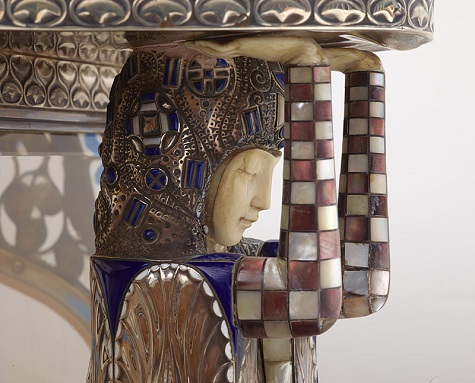
Two female figures, called “caryatids,” support the cabinet’s onyx top while emphasizing the verticality of the object and giving the flowing organic design an added sense of regal structure. Bright blue enamel and bold patterns draw the eye to these elegant figures.
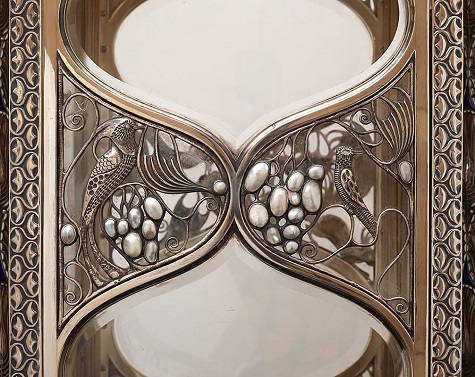
If you look closely, you will see a wide variety of birds, some with elaborate plumage and others so small they seem to disappear among the leaves and pearls. Gemstones dot the eyes of the birds, giving them a spark of life despite their metallic forms.
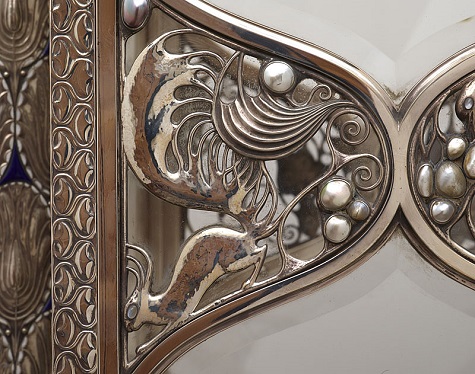
Squirrels frolic around the cabinet, hiding among the leaves and gathering pearls like acorns. Like the birds, their gemstone eyes enliven them and their differing poses suggest their distinct personalities. Further, the animals represent multiple breeds, including the red squirrel with tufted ears and the grey squirrel with rounded ears.
The cabinet by the numbers:
2 – caryatids
3 – cubic feet of wood
4 – interior glass shelves
5 – feet tall
10 – types of birds
14 – squirrels
If you look really closely, you will find other animals like lizards and mice!
Alexa Hayes is the McDermott Graduate Curatorial Intern for American and Decorative Art at the DMA.
Pet Parade: Strutting the Catwalk — and the Canvas
Published January 14, 2014 Collections 2 CommentsTags: Alexandre Hogue, Amedeo Modigliani, Ben Nicholson, Cesare Paolini, Dallas Museum of Art, DMA, dress up your pet day, Edward Hicks, Emile Bernard, Eugène Delacroix, Franco Teodoro, Frederic Edwin Church, Jackson Pollock, John Singer Sargent, Malaysia, Piero Gatti, Rembrandt Peale, Zanotta
Did you know January 14 is national Dress Up Your Pet Day? Yeah, we didn’t either. Here at the DMA, we not only love our art, but we also love our animals. We couldn’t resist combining some of our favorite works from our permanent collection with some of our favorite pet pals.
We promise that no animals were harmed in creating these photos. Well, maybe just a few pet egos.
DMA Staffer: Danielle Schulz, Teaching Specialist
DMA Pet: Ruby, Lab/Collie mix, age 2
Portrait Inspiration: Alexandre Hogue, Drouth Stricken Area, 1934
I wanted to transport Hogue’s characteristic desert-like scene to my tiny apartment, and lucky for me, I was able to find an eager canine ready to put on a cow costume and thirstily explore a bathtub water tank. This work will soon be on view in the upcoming exhibition Alexandre Hogue: The Erosion Series.
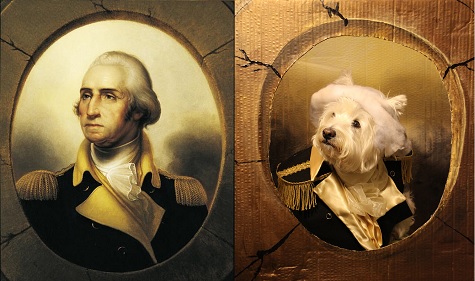
DMA Staffer: Amanda Blake, Head of Family, Access, and School Experiences
DMA Pet: George Costanza, West Highland White Terrier, age 7
Portrait Inspiration: Rembrandt Peale, George Washington, c. 1850
Like George Washington, George the Westie is courageous and fearless in the face of danger. He is an alpha dog and has been known to keep much larger dogs in line. Plus, I thought that he would look very handsome in a colonial costume.
(Editor’s note: This is George as himself, no airbrushing or Photoshop for him!)
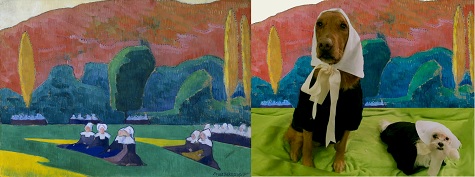
DMA Staffer: Andrea Severin Goins, Interpretation Specialist
DMA Pets: (from left to right) Shelby, Golden Retriever, age 6, and Artemisia Gentileschi (“Artie”), Malshi/Maltese/Shih Tzu Hybrid, age 4
Portrait Inspiration: Emile Bernard, Breton Women Attending a Pardon, 1892
Artemisia and Shelby love the outdoors; in particular Artie likes to sunbathe and Shelby loves to people watch while enjoying a nice breeze. They like Bernard’s painting because it looks like a place they would like to visit: a lush field, rich with bright hues, and filled with nice ladies who might pet them.
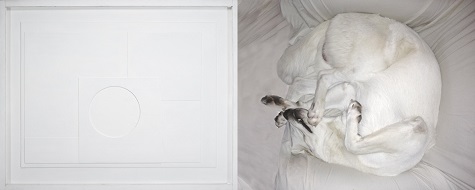
DMA Staffer: Chad Redmon, Assistant Photographer
DMA Pet: Ajax, White Alsatian, age 3
Portrait Inspiration: Ben Nicholson, 1936 (white relief), 1936
I’ve admired Ben Nicholson’s White Relief long before I was even an employee here at the DMA. I respond to minimal and reductive aesthetic strategies and this one is a stellar example of such. When I found Ajax asleep in my chair, viewed from that overhead perspective, my mind went immediately to the work by Nicholson. Quick iPhone shot and some simple Photoshopping and there it is.

DMA Staffer: Doug Landrith, Gallery Attendant
DMA Pets: (from left to right) Ella, Leopard Tortoise, age 5; Gurdy, Sulcata Tortoise, age 6; Tanaka, Red Foot Tortoise, age 7
Portrait Inspiration: Frederic Church, The Icebergs, 1861
Tortoises look like monumental rock formations anyway, so The Icebergs seemed like a perfect fit. It was honestly more entertaining having them roam around the yard with their ice hats on running into things.
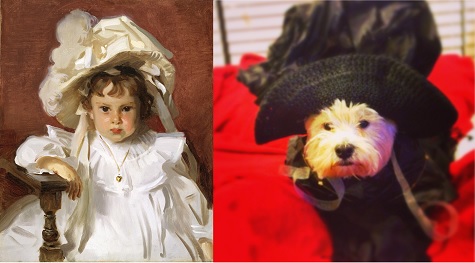
DMA Staffer: Kimberly Daniell, Manager of Communications and Public Affairs
DMA Pet: Chloe (she is actually my roommate’s dog. I dog-napped her for the photo shoot), West Highland Terrier, age 8
Portrait Inspiration: John Singer Sargent, Dorothy, 1900
Dorothy is one of my favorite works in the collection. Chloe is sassy and has an attitude and I envision Dorothy was the same way. A white ensemble did not show up well on her fur, so she went for a more brooding Dorothy look.
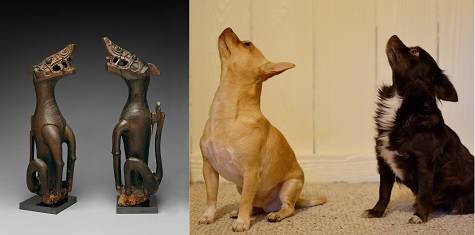
DMA Staffer: Jessica Fuentes, Gallery Coordinator for the Center for Creative Connections
DMA Pets: (from left to right) Fidel, Short Haired Chihuahua, age 3, and Nene, Long Haired Chihuahua, age 4.5
Portrait Inspiration: Pair of mythical animals (asos), 19th century
It’s only within the last six months or so that I have become familiar with the pair of mythical animals, as it is a piece that C3 focuses on for our Indonesian Gallery Pop-Up Art Spot. I love how these creatures are clearly dog-like and are a protective symbol. When thinking about which work of art I would pick for my dogs to re-enact, I immediately thought of this one. My pair of Chihuahuas may not be as graceful or intimidating as these mythical animals, but they are a source of comfort to me and my daughter. Clearly they do not realize how small they are, because they jump up, bark and chase after any foreign sound they hear. (In order to get them to sit up and pose like this, I had to enlist the help of my daughter… she is out of the frame, standing on a chair, holding a treat and telling them to “sit” and “stay.”)
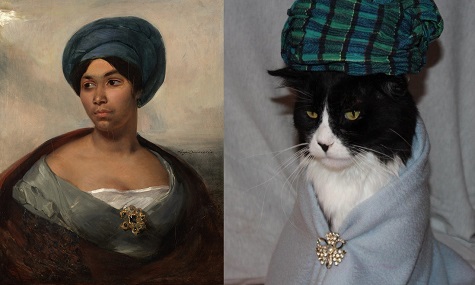
DMA Staffer: Queta Moore Watson, Senior Editor
DMA Pet: Ollie, Tuxedo Cat (Domestic Medium Hair), age 5
Portrait Inspiration: Eugène Delacroix, Portrait of a Woman in a Blue Turban, c. 1827
I chose this work because my cat Ollie shares with Eugène Delacroix’s subject a pensive expression and soulful eyes. Delacroix had a penchant for representing exotic women from foreign lands. While Ollie is a Domestic Medium Hair rather than an exotic breed, he does mirror the subject’s enigmatic gaze. Is he pondering the future? Remembering the past? Perhaps he is thinking, “I’m a cat. Why am I wearing a turban?”
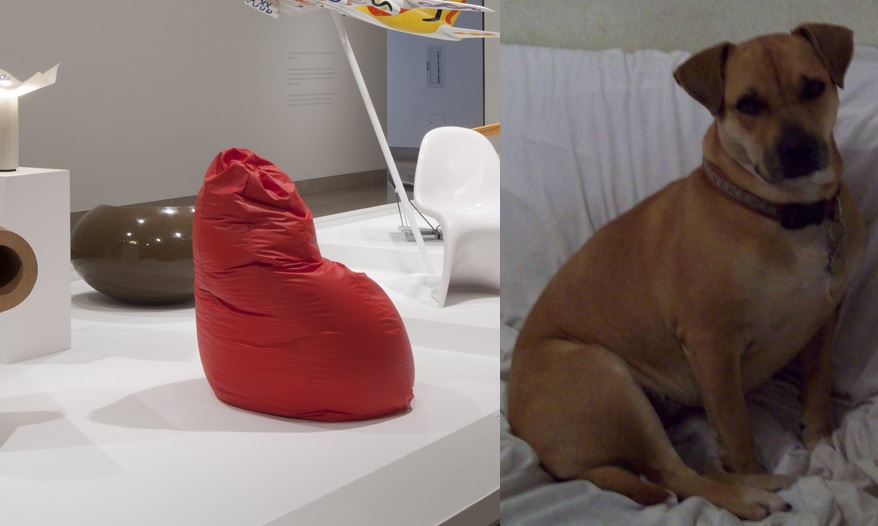
DMA Staffer: Reagan Duplisea, Associate Registrar, Exhibitions
DMA Pet: Mosey, Florida Brown Dog, age 9
Portrait Inspiration: Sacco chair, Piero Gatti, Cesare Paolini, Franco Teodoro, Zanotta, designed 1968-1969
A dear friend of mine once called Mosey “a little dumpling,” and even though she is really all muscle, the nickname stuck. She always sits sideways, directly on her rear end, and her “dumpling” shape reminds me of the red beanbag chair currently on view in the exhibition Form/Unformed: Design from 1960 to the Present.
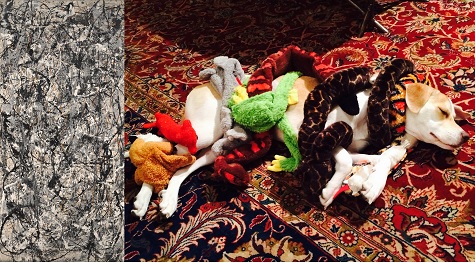
DMA Staffer: Catherine Cody, Special Events and Volunteer Relations Manager
DMA Pet: Jane, Mutt, age 1
Portrait Inspiration: Jackson Pollock, Cathedral, 1947
Pollock is one of my favorite painters, particularly in the way he suggests “energy made visible”. My dog Jane is the definition of visible energy, and her life often looks like a Pollock painting. She ate the string I bought to design our interpretation of Cathedral, so we improvised with some of her toys. I think Pollock would approve.
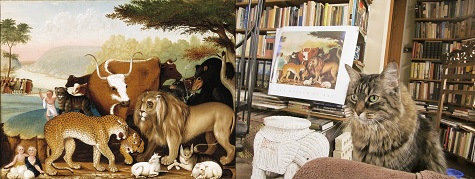
DMA Staffer: Anne Bromberg, The Cecil and Ida Green Curator of Ancient and Asian Art
DMA Pet: Miss Suzl, Maine Coon cat, age 4
Portrait Inspiration: Edward Hicks, The Peaceable Kingdom, c. 1846-1847
I thought Miss Suzl would be interested in the painting and probably recognize her big relations in it. I envision Miss Suzl’s comments on this painting are either “SOMETIMES I’m peaceable, but don’t count on it” or “wanting to lie down with a lamb instead of eating its nuts.”

DMA Staffer: Mandy Engleman, Director of Creative Services
DMA Pet: Sabrina, Bassador (Basset Hound/Yellow Lab), age 5.5
Portrait Inspiration: Amedeo Modigliani, Boy in Short Pants, 1918
Ever since I adopted Sabby, I’ve seen the similarities in her proportions to that of a Modigliani work. She has a short, long stocky body with an abnormally long neck and a smallish head. When attempting a photo shoot, however, she was not in the mood to show off that long neck. So instead you’ll see her similarity to Boy in Short Pants through her piercing eyes and elongated face. You may also see that she wanted to add a twist of Warhol—which is where her true personality lies.
Visit the DMA’s collection galleries, included in free general admission, to find inspiration for your pet’s high fashion and share your photos #DMApets!
Images: Alexandre Hogue, Drouth Stricken Area, 1934, oil on canvas, Dallas Museum of Art, Dallas Art Association Purchase, (c) Olivia Hogue Marino & Amalia Marino; Rembrandt Peale, George Washington, c. 1850, oil on canvas, Dallas Museum of Art, The Karl and Esther Hoblitzelle Collection, gift of the Hoblitzelle Foundation; Emile Bernard, Breton Women Attending a Pardon, 1892, oil on cardboard, Dallas Museum of Art, The Art Museum League Fund; Ben Nicholson, 1936 (white relief), 1936, oil on carved board, Dallas Museum of Art, Foundation for the Arts Collection, © 2011 Artists Rights Society (ARS), New York / DACS, London; Frederic Edwin Church, The Icebergs, 1861, oil on canvas, Dallas Museum of Art, gift of Norma and Lamar Hunt; John Singer Sargent, Dorothy, 1900, oil on canvas, Dallas Museum of Art, gift of the Leland Fikes Foundation, Inc.; Pair of mythical animals (asos), Malaysia, Sarawak, middle Rajang River region, Greater Sunda Islands, Kayan people, 19th century, wood, Dallas Museum of Art, The Roberta Coke Camp Fund and the Museum League Purchase Fund; Eugène Delacroix, Portrait of a Woman in a Blue Turban, c. 1827, oil on canvas, Dallas Museum of Art, The Eugene and Margaret McDermott Art Fund, Inc., in honor of Patricia McBride; Sacco, Piero Gatti, Cesare Paolini, and Franco Teodoro, designers; Zanotta, maker, designed 1968-1969, vinyl and polystyrene, Dallas Museum of Art, gift of Zanotta; Jackson Pollock, Cathedral, 1947, enamel and aluminum paint on canvas, Dallas Museum of Art, gift of Mr. and Mrs. Bernard J. Reis, © Pollock-Krasner Foundation / Artists Rights Society (ARS), New York; Edward Hicks, The Peaceable Kingdom, c. 1846-1847, oil on canvas, Dallas Museum of Art, The Art Museum League Fund; Amedeo Modigliani, Boy in Short Pants, c. 1918, oil on canvas, Dallas Museum of Art, gift of the Leland Fikes Foundation, Inc.
Catherine Cody is special events and volunteer relations manager and Kimberly Daniell is the communications and public affairs manager at the DMA.
Celebrating Friendship: The First 12 Months of DMA Friends
Published January 13, 2014 Center for Creative Connections , Collections , Dallas , DFW , DMA Friends , Education , Late Nights ClosedTags: Dallas Museum of Art, DMA, DMA Friends, Late Night
The DMA Friends program turns a year old this month, and what a year it’s been! Our DMA Friends have helped reshape the way people visit the Museum—collecting points and badges—and the experiences they have at the DMA. There are so many highlights that we decided to recap some of the greatest hits of the past 12 months.
January – Let’s Get This Party Started

We launched the DMA Friends program, as well as our return to free general admission, with a day full of free activities on January 21, 2013. By the end of that first day, we had over 800 new friends. New DMA Friends have continued to join with enthusiasm—in fact, we welcomed the largest number of DMA Friends between December 26 and 31. Happy Anniversary, DMA Friends!
February – Busy Bees
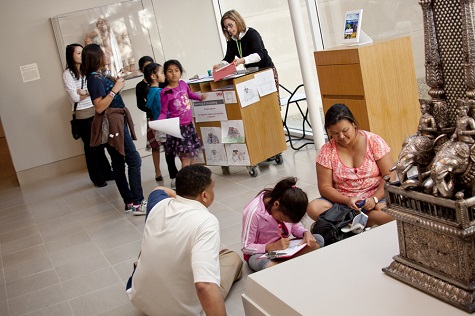
The first full month of our new gallery activity, the Pop-Up Art Spot, was very pop-ular. DMA Friends love taking a creative break in the galleries with inspiration from the DMA’s collection. The Pop-Up Art Spot is currently the most popular activity for DMA Friends.
March – Rewarding Rewards
With all of their visits, activities and check ins, DMA Friends started raking in their points quickly. Our first high value reward, Dinner and Movie, was redeemed only two months after the launch of DMA Friends. It was the first of many special rewards redeemed this year, including the Art Beauty Shoppe reward, which you can read more about here.
April – Cindy Sherman Doppelgängers
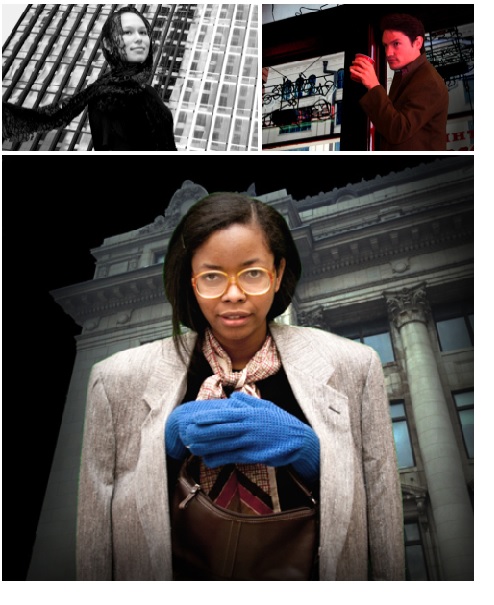
We encouraged DMA Friends to test their creativity with our Cindy Sherman Super Fan activity. DMA Friends grabbed their wigs, costumes and cameras and tweeted their interpretation of Cindy Sherman for extra points and a bonus badge. DMA staff even got in on the fun—see more here.
May – Hera, Medusa and Zeus. Oh My!
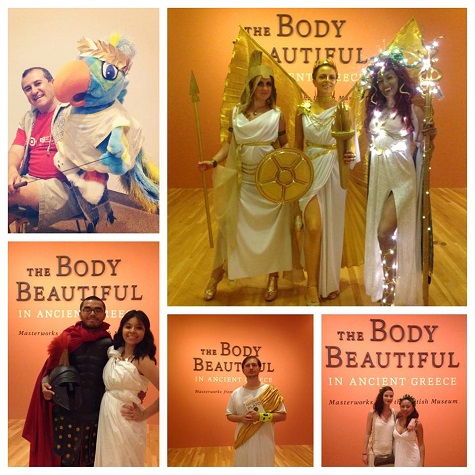
Throughout the year, DMA Friends have had the opportunity to earn special limited-edition badges. In May, those who came to Late Night dressed as their favorite Greek hero received the Midnight Masquerade Badge, not to mention some adoring and impressed fans.
June – Indonesian Celebration
The DMA celebrated the award-winning catalogue Eyes of the Ancestors: The Arts of Island Southeast Asia at the Dallas Museum of Art with a week of activities, which was right up our DMA Friends alleys. The DMA’s Asian Galleries received the most visits by DMA Friends, with over 18,000 check-ins!
July – The President and Mrs. John F. Kennedy
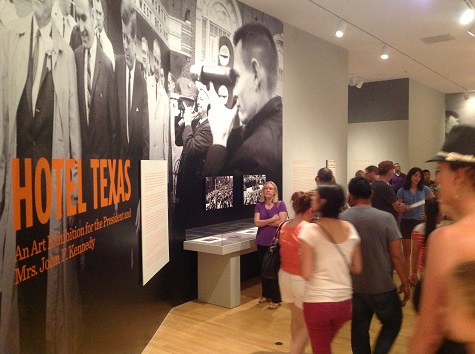
We were halfway through our presentation of the DMA-organized exhibition Hotel Texas: An Art Exhibition for the President and Mrs. John F. Kennedy in July. This exhibition was the most visited exhibition of 2013 by DMA Friends.
August – Into the Deep

The DMA Friends reward Into the Deep was featured in the Dallas Observer in August. Since the launch of DMA Friends, 26 guests have explored the Museum’s art storage by redeeming this exclusive reward.
September – Coast to Coast
In September, we received great news: the DMA was awarded an IMLS grant to help fund the expansion of a platform of engagement based on the DMA Friends program to partner institutions, including the Denver Art Museum, Los Angeles County Museum of Art, and Minneapolis Institute of Arts. Stay tuned this year for exciting news as their plans develop.
October – Late Nights, High Numbers
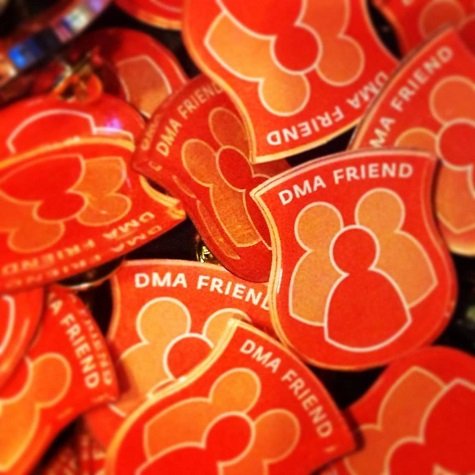
Ten months into our program, we reached over 30,000 new DMA Friends! And they loved October’s Late Night, when we welcomed the largest number of new DMA Friends during our monthly event.
November – Overnight at the Museum
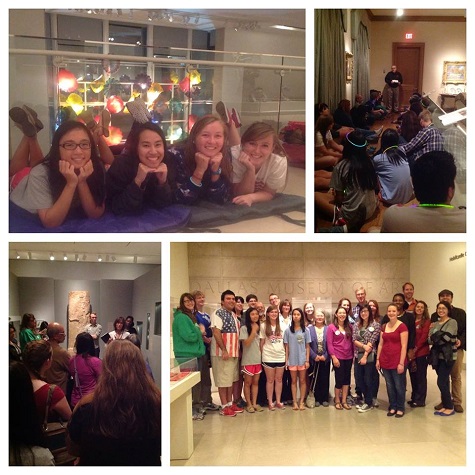
Ten DMA Friends visited exhibitions, attended lectures, created art at the Art Spot and more to earn 100,000 points since the launch in January. Those DMA Friends and a few of their buddies were the first people to ever spend the night at the DMA. Read about their fun overnight adventure here and start saving your points now!
December – Feeling the Love
DMA Friends are making news around the world! In December, The Economist magazine put the spotlight on DMA Friends with its “How to Win Friends” article on the program.
Celebrate the first year of DMA Friends, as well as the DMA’s 111th birthday, this Friday during Late Night. We have a lot of fun events in store, including a few surprises for DMA Friends! Check out the Late Night schedule here to start planning everything you want to do.
If you aren’t already a DMA Friend, be sure to sign up for the free program on your next visit.
Kimberly Daniell is the manager of communications and public affairs at the DMA and Sarah Coffey is the assistant to the chair of learning initiatives at the DMA.
